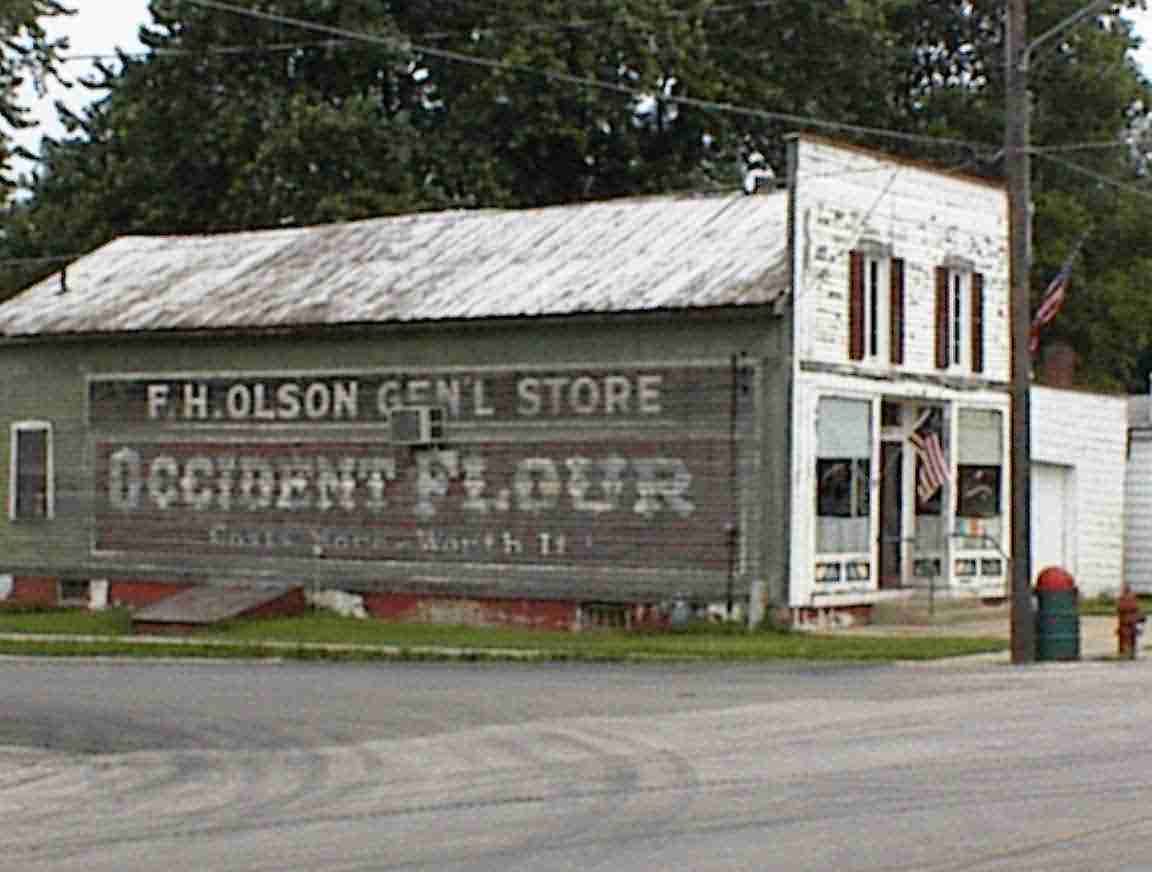
4 July - Day 36: Galesburg IL to Hennepin Canal IL - 102.8 km @ 20.4 km/h
I started the day with the ‘Weather Channel’ and they forecast winds from the South. Of course when I exited the hotel they were coming from the East; it seems as though an inability to accurately forecast weather is a universal trait. It should be more accurate in the middle of a continent such as this, but it is not. They forecast a 40% probability of rain and this was definitely an underestimate.
The motel was close to the centre of town and there was a beautiful red sandstone church on the main circle. It was built in 1898 with the stone imported all the way from Michigan. There were several magnificent stained glass windows including a huge round one. I tried to photograph it but my camera would not do it justice.
There were a lot of shops on the main street which were empty. This reminded of what I had seen in the west but the town at least didn’t have the air of despair that I had seen so often elsewhere. I had a pancake breakfast in a local restaurant and then headed out of town.
My plan was to head East and then North along the Illinois river. However, due to the wind I changed my plans and headed NE along Highway 34. This served to make the wind on an angle, but it was preferable to having a pure headwind.
The road ran parallel to the railway line and although it was largely flat, it was slow going due to the wind. It is really quite ironic that in all my research I read that the dominant wind was from the West but since leaving the Rockies it has been every direction except the west.
I passed through a number of small communities. Since it was 4th July they were essentially deserted. The only thing open was the petrol stations; these seem to never close! In one community there was a delightful old village shop which had an advertisement on the side as shown below. At one stage it was quite common and I have seen everything advertised from coal to caskets. I often wonder what happened to the companies that made these products. Whether they just shut down or were the forerunners of what we have today.

Illinois has more historical plaques than Iowa, but less than I saw in Colorado and Utah. I saw one on a stone that was overgrown so I went over and had a look. It commemorated a raid made on local Indians in 1780 using a collection of French, Spanish and Americans in retaliation for raids by the Indians. I found it fascinating that over 200 years ago the Spanish were operating this far north. This was before the Louisiana purchase, when the U.S.A. bought the Mississippi region from France in the early 1800s, so I was surprised that the Americans were involved.
I came across another plaque near ‘Bishop’s Hill’. This commemorated a Swedish religious community that was established in the area in the 1840s. After starting to farm 16,000 acres the leader was murdered after about 5 years. Later on there was dissension and the community split after about 15 years. I found it ironic since it is a pattern which has been repeated so often. There are strong leaders who dominate through their strength of personality. Once they are no longer in charge things fall apart. We seem to want to be followers …
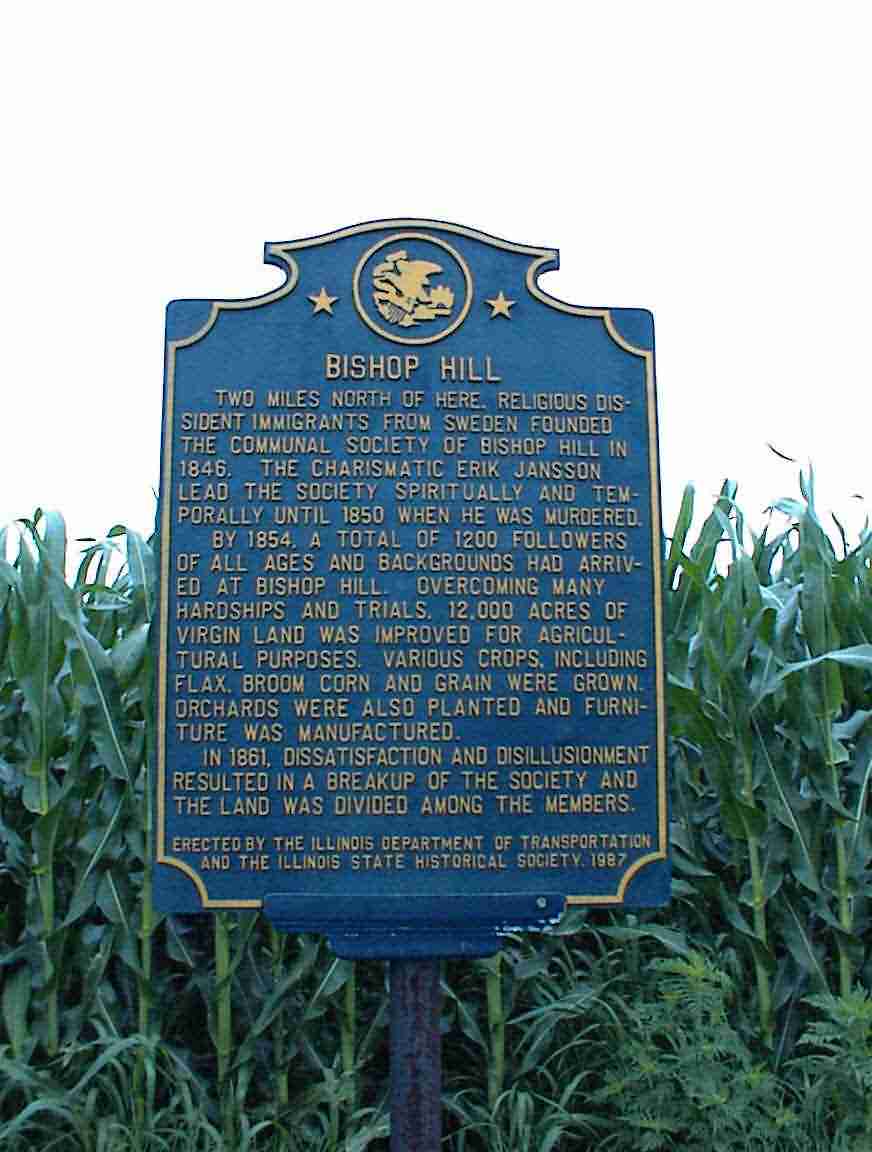
I entered the town of Galva which proudly announced that it was settled by Swedes who originally called in Galve after their home in Sweden, but they anglicised it to Galva. There were quite a few Scandinavians who settled in this area, and there is a monument to the Norwegian settlers. I read that the railway stations were polyglots of languages with everything from Chinese to Irish to Italian to ???
There was this house bedecked for the 4th July in town as shown below. It not only had flags but lots of garden ornaments such as gnomes, deer, people, etc. These are very common, particularly deer. They are about the size of a large cat, sometimes as big as a German Shepherd dog, and are planted looking out towards the road. I found one place where they were a bit cheeky. There were several deer statues in the front yard but the barn had nailed to it about 2 dozen sets of antlers. I don’t think that the statues were decoys, but it was a bit ironic nonetheless. It was interesting to see how different each set of antlers was. The other funny statue I saw was that of a dog. They had connected a hose to it so it looked like it had the world’s biggest bladder.
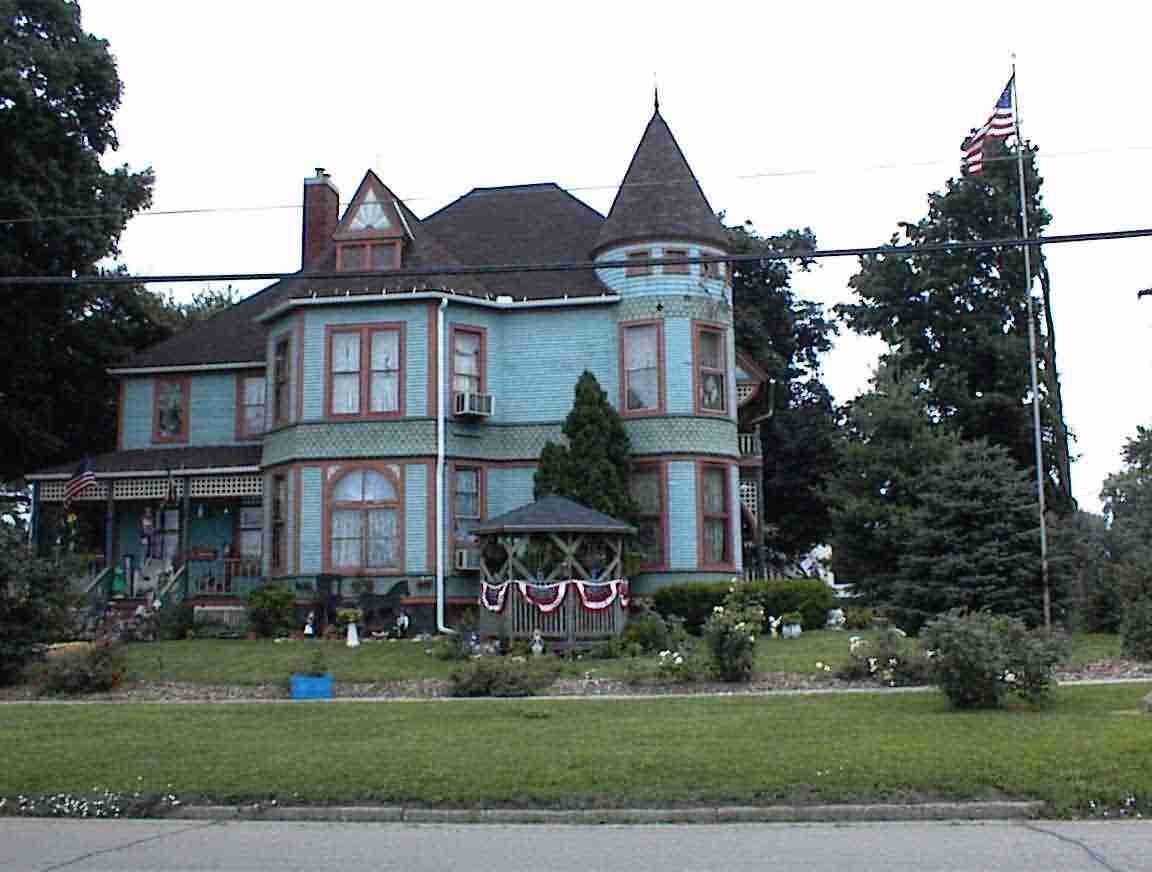
I was stopped by a policeman—Officer T. Bennett, no relation—and advised that the road was closed due to the town parade. I was in for that so I cycled on, parked my bike, and enjoyed the next hour. Let me explain … in movies they have these quaint parades which reflect the full cross-section of the communities. I always thought, yeah, right, but that is what I saw. It was amazing. The whole community seemed to be out, sitting on the sidewalk in their garden chairs (see below). They were the audience for an array of parade participants which can best be described as anything that could move and wanted to participate.
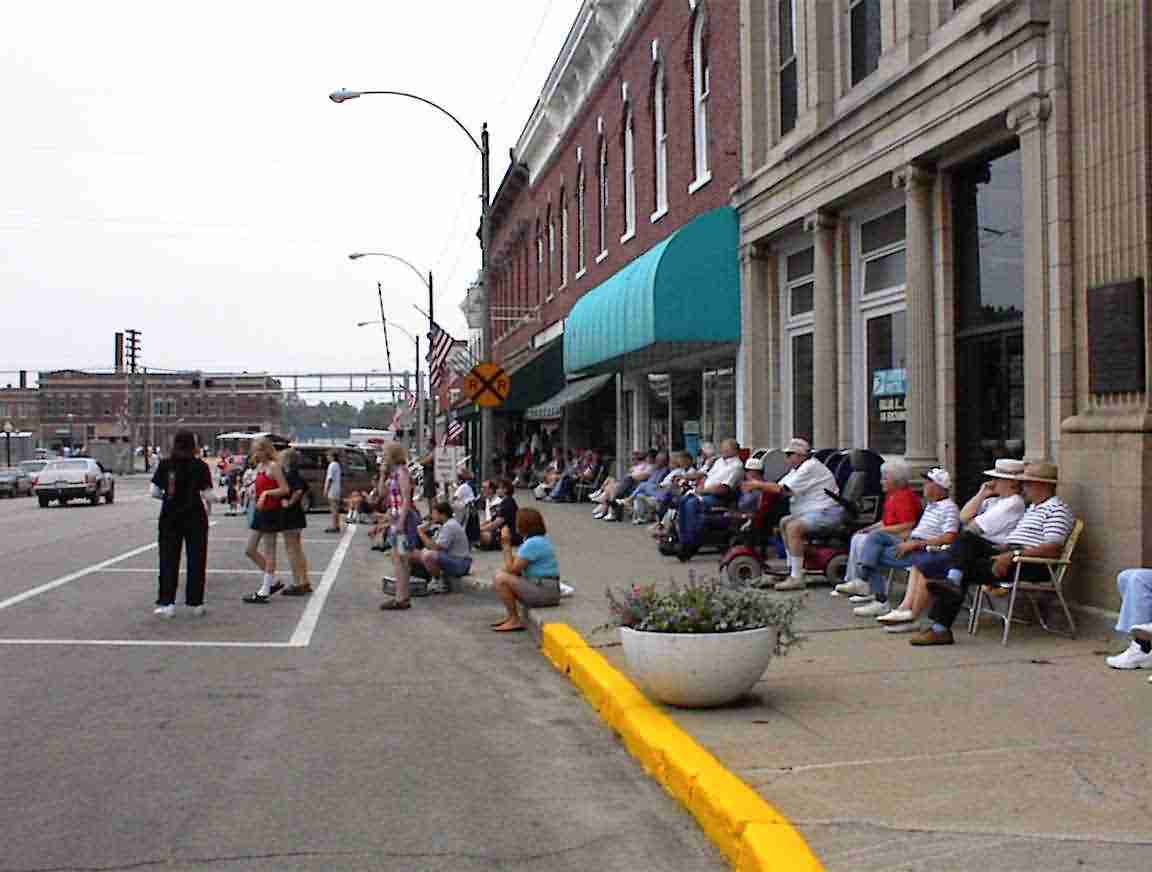
You think I exaggerate? Look at the following photos. You will see everything from fire engines to lawn mowers to tractors. There were vintage cars and modern cars. There were ‘Shriners’ on their motorcycles, there were politicians, kids on the back of trucks, a band in a sled, and the high school cheer leaders on the back of a truck. What was missing was the high school marching band—winners of the 1999 Illinois championship (announced by the sign as I entered the town).
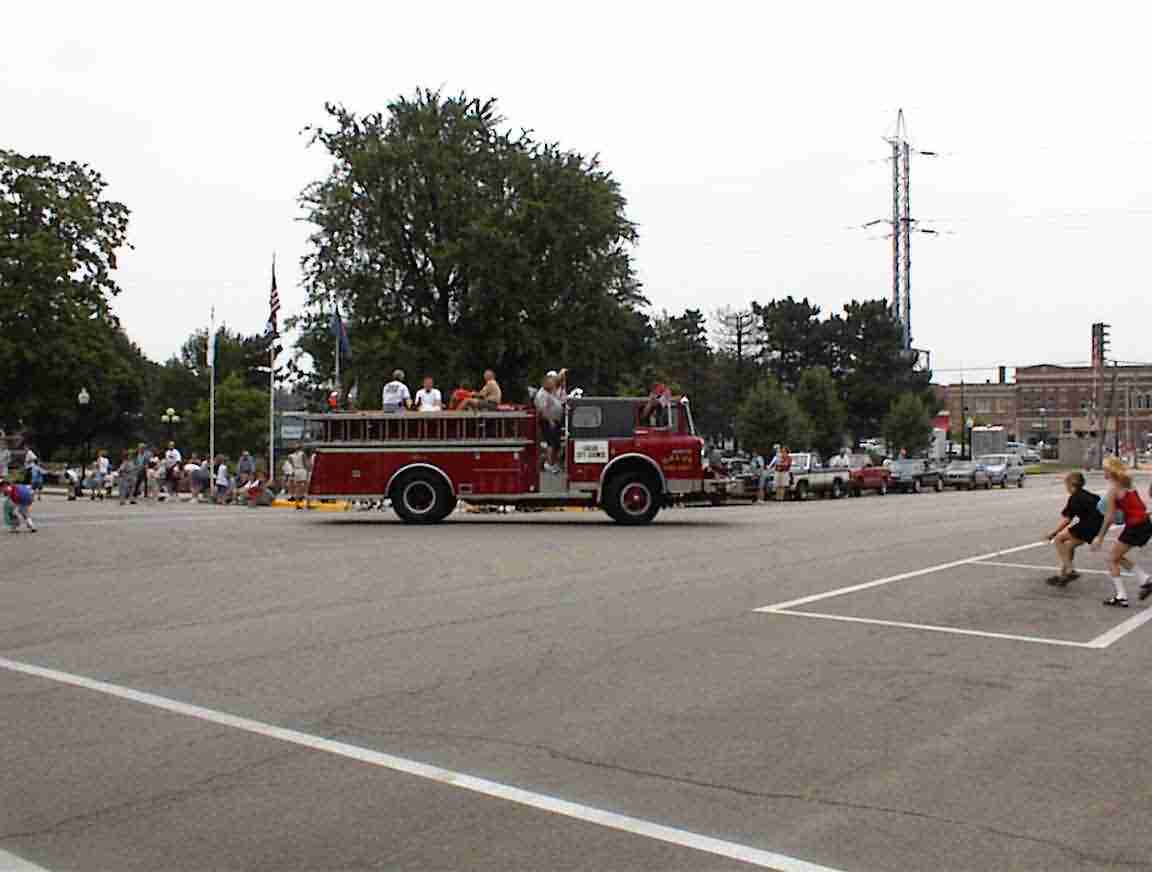
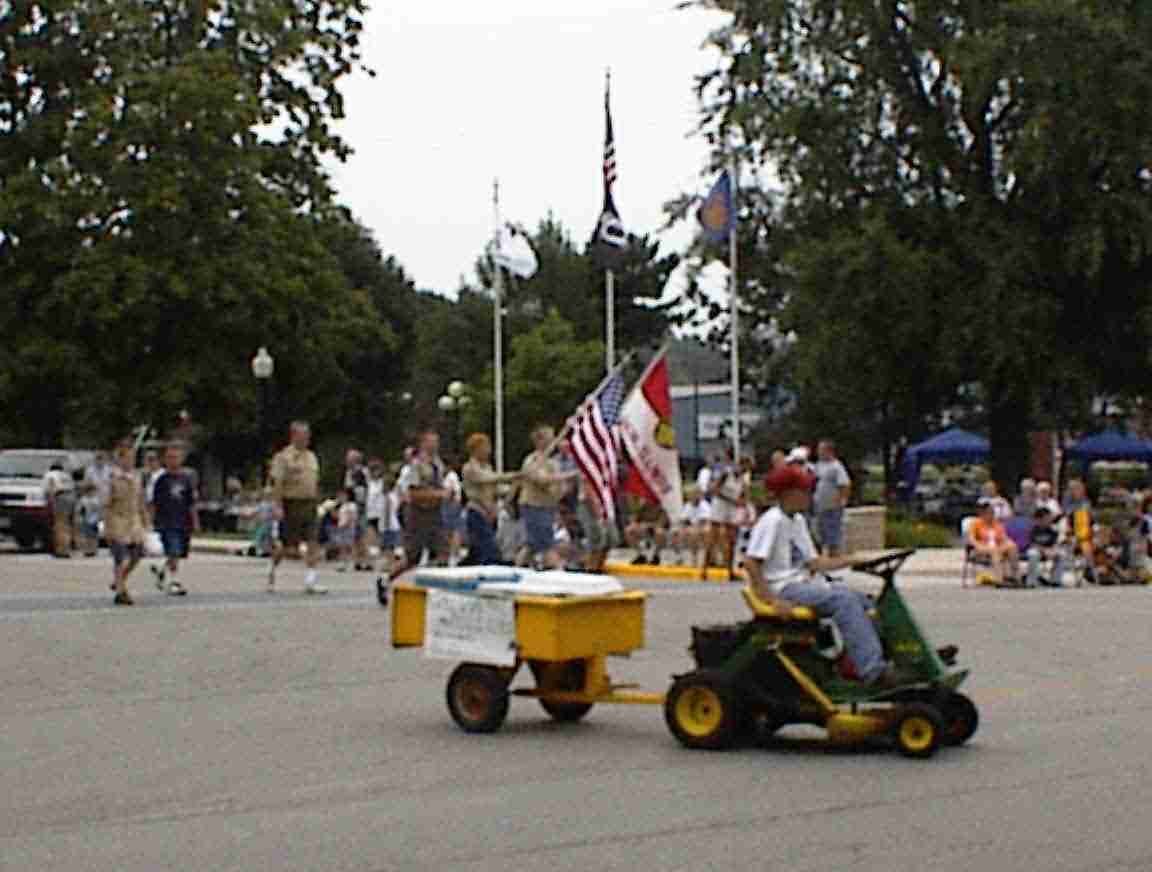
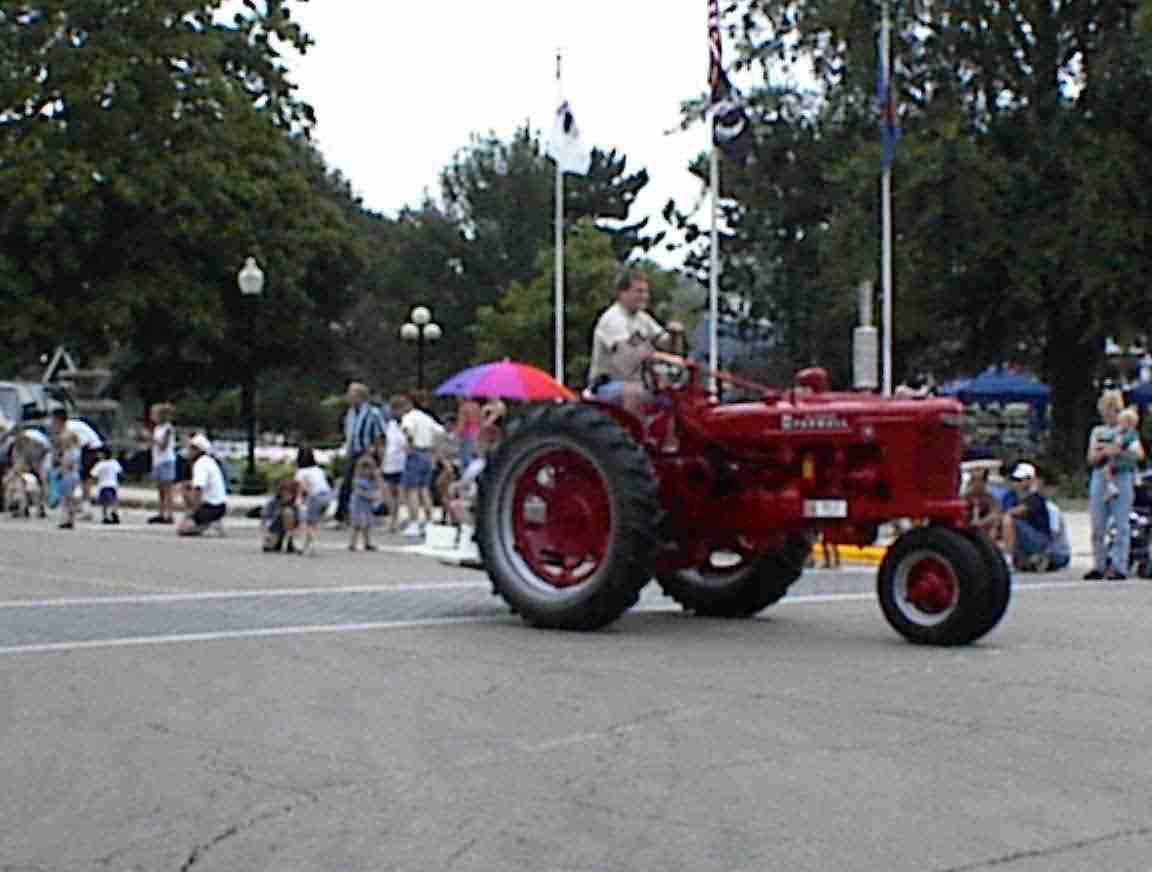
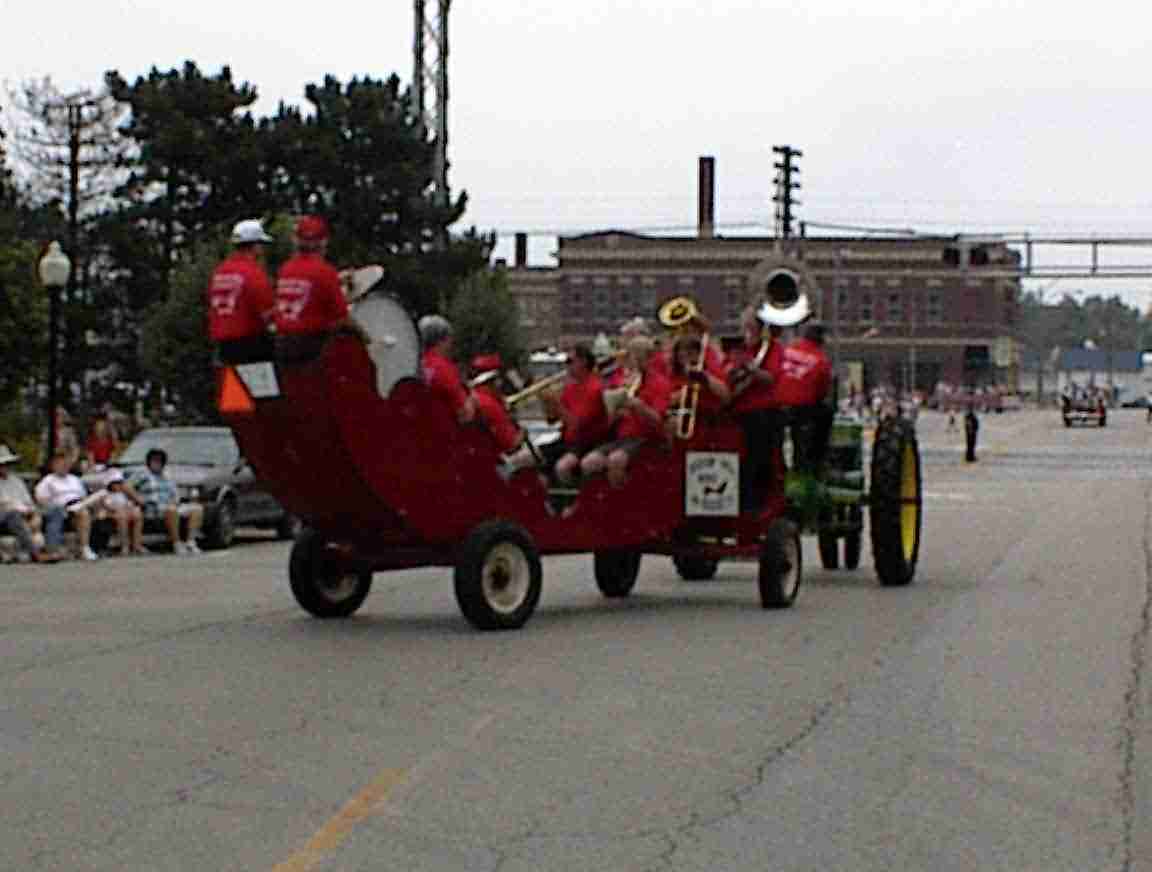
The participants in the parade threw out candies to the spectators and there were three young girls who had plastic bags and scrambled for everything they could get—which was quite a lot! I tried a ‘Tootsie Roll’ as I had enjoyed these as a teenager. My taste buds have matured with age and I found them absolutely unpalatable.
I chatted with a local policeman who showed the knowledge of geography that I have found so disconcerting during my travels. After saying that I was from New Zealand he said that there was someone from my part of the world in the parade: a Swede. Seriously. Then again, that was bettered the next day by the 14 year old girl who asked me where Boston was. She had heard of it but didn’t know where it was. Seriously. I apologise to my American friends, but there is a real education gap here when it comes to geography (and history).
An elderly gentleman came over and spoke with me. His name was Marty Looney (yes, that’s right) and he was 85 years old. He had spent his whole life in town and had seen every parade except when he was overseas at war. He was in the 82nd Airborne Division and was wounded 4 times. I said that I thought that if you were wounded once you were sent home. Not so he said, even if you were badly injured they still tried to keep you on. He said that he was part of the glider borne troops and ‘crashed’ 9 times. I said wouldn’t it be better to use a parachute than to be in those wooden gliders and he replied that at least in a glider if you survived the landing you weren’t alone; with parachutes you could land anywhere and find yourself in deep trouble. Made sense to me.
He said that he had received four ‘Purple Heart Medals’ for being wounded. I asked him if he knew why the highway in Nebraska was called the ‘Purple Heart Highway’, but unfortunately he didn’t hadn’t heard of this. It is a quaint American practice to give highways names. I had been on the ‘Henry Fonda Highway’; ‘Corn Husker Highway’, ‘Purple Heart Highway’—and these were all the same road—along with others in different states. One popular name was the ‘Grand Army of the Republic Highway’ as I encountered this in two or three different states on totally different roads.
While I was talking with Marty the American Legion members marched by. These are former soldiers and, although the youngest would have been 70, they sure knew how to march. When they got to the curve where I was positioned the innermost went to a 1/3 step as they wheeled around. All the time they were in step with their old rifles held proudly on their shoulders. I was impressed. I contrasted this with the N.Z. army troops Lis and I saw at the Auckland Cenotaph on ANZAC day who couldn’t even keep in step in a straight line. But the best are the U.S. Marines who have a real crack drill squad. It’s something I’ve always appreciated as when I was an Air Cadet as a child we tried (unsuccessfully) to have a good drill team. It is mighty hard work.
Eventually the parade ended and I cycled on to Kewanee where I had my standard fare for lunch: a vegetarian sub at Subway. They are good, but I’m mighty tired of them! While I was there it started raining very heavily so I was thankful to be indoors. It had felt like rain and I had put on the effort for the last 10 km and just managed to beat the storm. After the rain passed it was still dark but I decided to head across the street to the market where I bought some fruit.
As I cycled off from the market it started to rain so I went back across the road and went into the Boomerang Café to have a smoothie and to wait for the storm to pass. It was quite a wait as I was there for about 4 hours! The proprietor’s name was Eve Przybyla and, as you can probably guess, she was from Poland instead of Australia which is what I expected with a name like the Boomerang. When Eve heard that I was from NZ she got all excited as NZ (and Australia) were places she had always wanted to go. Indeed, one of her first questions was ‘Are there any Polacks in NZ?’. I was taken aback since the term Polack was a somewhat derisory term for Poles that we tended to avoid in Canada, but I guess it is acceptable in this part of America. I said that I only knew of one but that I’m sure that there would be more in Australia.
I cannot begin to describe how friendly everyone was towards me. Her husband and a friend were installing an ice cream machine. Her children were there as was one of the friend’s, and her mother, who was visiting from Poland and didn’t speak English, was also there. Our conversation ranged over a wide area, from my observations on America to life in NZ. It was particularly interesting talking with their friend who was a full-time farmer as he was able to answer some questions which had been bothering me for a while.
One of local practices is to put signs up for the seeds that are in the fields. One will pass fields with ‘Pioneer 35175’ etc. A sign which caught my particular attention was ‘Roundup Ready’ and I asked the farmer what this meant. Apparently, soy beans are a somewhat sensitive crop and susceptible to weed problems. The developed a genetically modified crop which is immune to the poison ‘Roundup’. This makes it possible to spray the soy bean fields with Roundup which kills everything, except the soy crop. He explained that they also have special corn which is corn borer resistant and that most crops are genetically modified in some fashion.
I commented that it would seem from an economic perspective much wiser to use organic growing techniques but he said that even though the retail price for organic produce is very high, that is not passed onto growers so it is not worth their while. It seems that last year a bushel of soy beans was worth $5 and if you didn’t use genetically modified crops you got $5.05—a 1% difference. He said that given the extra effort and hassles of not using Roundup it is a better idea to us the genetically modified seed stock.
I was surprised at his comment that the farms are not financially viable given the huge farms that I had been passing. He said that their main competition is from Argentina and Chile where they have even bigger farms, and lower labour costs. The U.S. government has adopted a policy of minimum price supports which are paid to farmers to ensure that they have an adequate income. We used to have these in N.Z. but they were done away with 15+ years ago and our farmers now compete openly and fairly on the world market. It is a pity that the Americans don’t do this as ultimate free trade would benefit the consumers. But given how political things are here, I don’t think that would ever happen.
The rain eventually stopped and as I readied myself to go I took the photo below of the gang at the Boomerang. I cycled off and stopped at a chemist to call N.Z. when Eve’s husband returned a couple of my (sodden) maps that had fallen out of my bag as I cycled off. From there I eventually found Highway 35 and headed NE. The road followed the railway line and it was hard work as there was still a headwind. For the first time I noticed passenger trains—mainly empty—but there was little other traffic, particularly on road. One who passed me was a cyclist and he offered to let me crash at his place as it was still a fairly stormy afternoon. Thoroughly tempted I declined as I wanted to try and put some distance down before sunset. He said that every Tuesday he cycled to work in Peoria, a distance of 60 miles, and was most impressed with the idea of a trans-America trip.
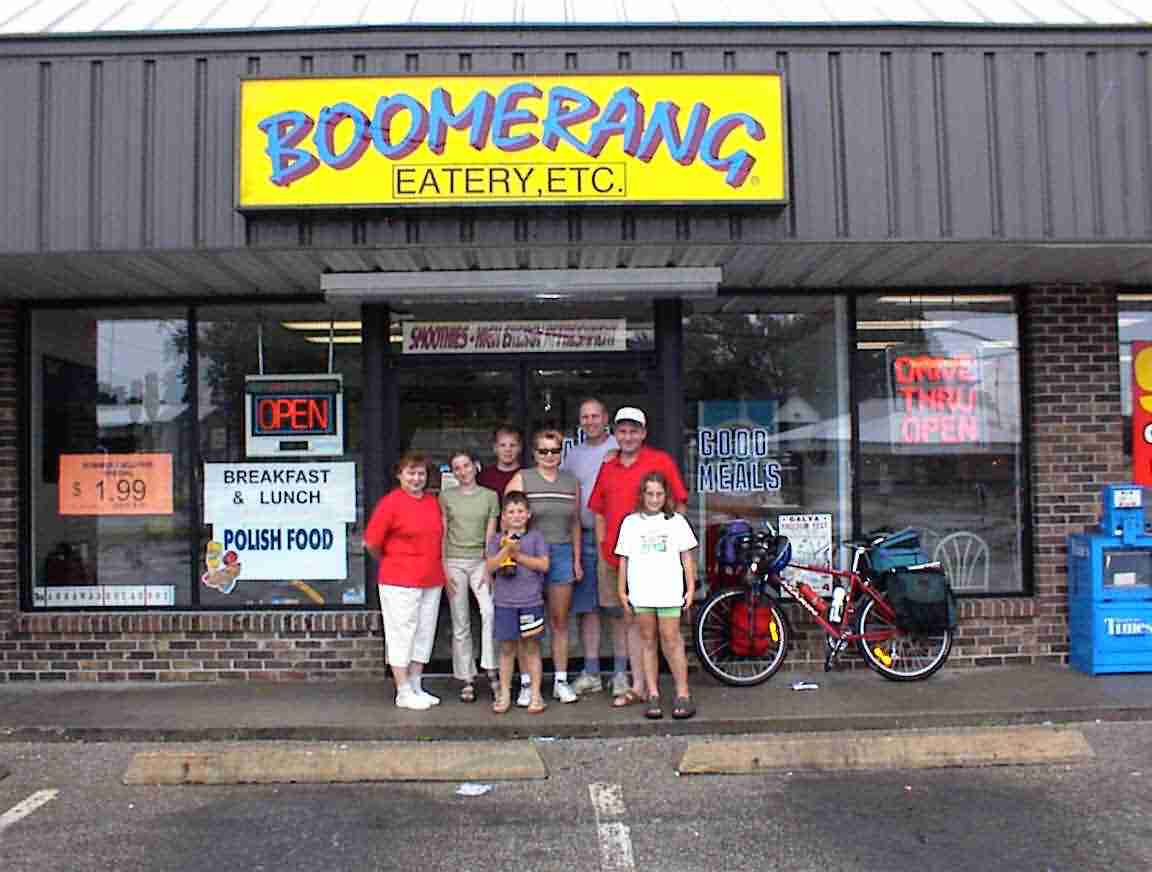
My goal for that evening was the town of Princeton (not the university town by the same name) but when I got close to it there was a sign that the bridge was out and the road closed. A few days earlier I had been reading in the newspaper how 35% of the nation’s bridges are sub-standard and many are being closed since they don’t have the funds for maintenance. I had done well to have come this far with no road closures. Checking my map, which only had major roads, there were not many choices open to me which didn’t involved a long cycle. However, there was a Visitor’s Centre a few miles away at the Hennepin Canal so I resolved to cycle over there and see if I could get some advice. I was also secretly hoping that the canal towpath would be suitable for cycling.
The centre was closed and the towpath was an impenetrable mud bath so I decided to try and get around the bridge somehow. As I was leaving a ranger drove up so I asked his advice. Yes, there was a route around the bridge which didn’t involve too much of a bypass. He suggested that I go a couple of miles up to the highway and check into a motel which I decided was a good idea given that the weather was still unsettled. My decision was verified when it started to rain just as I arrived to check in.
It was a Day’s Inn and was more upmarket than the others I’d stayed in, but I didn’t care. Surprisingly, the manager was an Aussie who had married a mid-Westerner and now found himself in this part of the world. He wasn’t too happy with the winters and they were planning on moving to Arizona where he was going to start a camel touring company. Apparently he had a lot of experience doing this in the Northern Territory and his idea was to offer an Aussie camel safari without having to leave the U.S.A. I think it’s brilliant. He also planned on doing a camel trek to Vermont in Autumn. Imagine looking at all those leaves from 3 m off the ground. However, it wouldn’t be paradise as I recalled the time in India where a colleagues partner wrote a short story called ‘Three Days Downwind from a Farting Camel’. Apparently, camels (at least Indian ones) have a major problem with flatulence. When I asked the Aussie about this he shrugged and said "it’s just part of the experience".
I did some work and made some calls to N.Z. before having a nice long hot bath and retiring. These motels are definitely more comfortable than my one-person tent and air mattress, although harder on the pocketbook.
loans loans loans loans loans loans loans loans loans loans loans loans loans loans loans loans loans loans loans loans loans loans loans loans loans loans loans loans loans loans loans loans loansloans loans loans loans loans loans loans insurance insurance mortgage mortgage